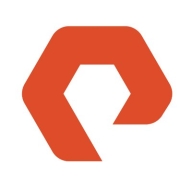


Pure Storage FlashBlade and Pavilion HyperParallel Flash Array are competitive storage solutions. Pavilion HyperParallel Flash Array is noted for its advanced features, making it worth the investment for many users.
Features: Pure Storage FlashBlade is known for high-speed performance, scalability, and ease of deployment. Pavilion HyperParallel Flash Array offers impressive parallel processing capabilities, multi-platform support, and enhanced data protection features.
Room for Improvement: Pure Storage FlashBlade needs better handling of mixed workloads, improved integration tools, and optimized cost-efficiency for smaller deployments. Pavilion HyperParallel Flash Array requires enhanced documentation, more robust firmware update support, and streamlined system updates.
Ease of Deployment and Customer Service: Pure Storage FlashBlade is praised for straightforward deployment and outstanding customer service. Pavilion HyperParallel Flash Array's deployment is more complex but supported by extensive installation guides, yet its customer service can benefit from improvements.
Pricing and ROI: Pure Storage FlashBlade has a high initial setup cost but delivers excellent ROI through performance benefits. Pavilion HyperParallel Flash Array also has a significant setup cost, providing exceptional ROI due to its advanced features, particularly for feature-driven investments.


Pure Storage FlashArray//X is the world’s first enterprise-class, all-NVMe flash storage array. It represents a new class of storage – shared accelerated storage, which is a term coined by Gartner – that delivers major breakthroughs in performance, simplicity, and consolidation.
Pavilion HyperParallel Data Platform
The Pavilion HyperParallel Data Platform™ dramatically accelerates what organizations achieve by delivering universally unmatched storage performance, in an incredibly compact solution while reducing data center costs and complexity. Unrivaled flexibility for multiple data types and protocols, along with broad ecosystem integration, ensure that every customer has choice and control.
What is the Pavilion HyperParallel Data Platform
The Pavilion HyperParallel Data Platform is comprised of the Pavilion HyperParallel Flash Array™ and Pavilion HyperOS™. The Pavilion HyperParallel Flash Array leverages a unique, switch-based architecture to create a multi-controller solution that delivers an unmatched combination of high performance, ultra-low latency, and storage density. Pavilion HyperOS is a powerful, purpose-built storage operating system designed to unlock the power of the multi-controller Pavilion HyperParallel Flash Array, which delivers scalability and flexibility that no other solution can offer.
Pavilion HyperParallel Data Platform Data Sheet
Download the Pavilion HyperParallel Data Platform data sheet. Updated: December 2020
FlashBlade is the industry’s most advanced scale-out storage for unstructured data, powered by a modern, massively parallel architecture to consolidate complex data silos (like backup appliances and data lakes) and accelerate tomorrow’s discoveries and insights.
We monitor all All-Flash Storage reviews to prevent fraudulent reviews and keep review quality high. We do not post reviews by company employees or direct competitors. We validate each review for authenticity via cross-reference with LinkedIn, and personal follow-up with the reviewer when necessary.